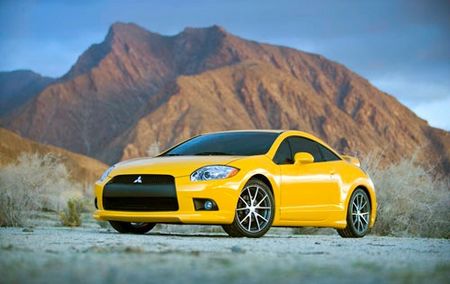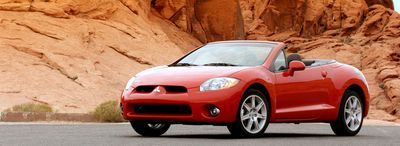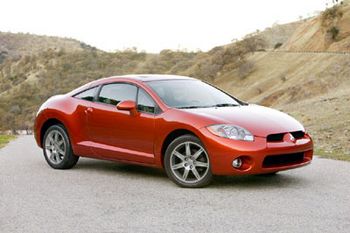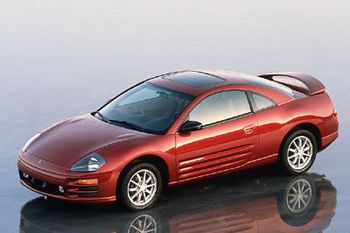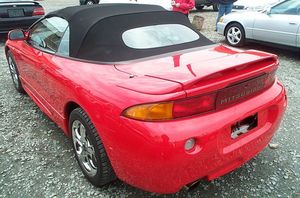.
Mitsubishi Eclipse
The Mitsubishi Eclipse is a two-door, four-seat sports car that has been in production since 1990. The Eclipse is produced solely for the United States and Canadian markets, where it has also been built as the Eagle Talon and the Plymouth Laser through the Mitsubishi Motors Corporation's close relationship with the Chrysler Corporation (now DaimlerChrysler) Their partnership was known as Diamond Star Motors, or DSM. Eclipses are popular among racers, and other automotive enthusiasts in part because of the car's low price and wealth of aftermarket parts.
See Wikicars' comprehensive Mitsubishi Eclipse Review.
Recent Changes
- Having been newly redesigned for the 2006 model year, the Eclipse remains mostly unchanged for 2007, save for a handful of new exterior colors and some updates in options packages. The biggest change for 2007 comes in the form of a convertible body style, the Eclipse Spyder, which comes in two trims and shares the same engines as its coupe conterparts.
- For 2009, The Mitsubishi Eclipse receives a mid-cycle facelift.[1]
Styles and Major Options
The 2007 is available in either a coupe or a convertible and three total trims: the GS, SE, and GT. The convertible Spyder does not come in an SE trim, and though the choice in engines is the same, the Spyders V6 just slightly less powerful than that found in the Coupe (260hp versus 263hp). The I-4 is a 2.4L 162hp engine. Here are some of the features found in the individual trim levels:
Eclipse GS
- 2.4L 162hp I-4 engine
- 17" silver alloy wheels
- 6-way driver (4-way passenger) sports seats
- Premium cloth seating
- 6-speaker AM/FM/MP3/CD audio system
- Power windows, locks, and mirrors
Eclipse SE
Adds to or replaces GS features with:
- 18" silver alloy wheels
- Leather seating
- Express open sunroof
- 9-speaker Rockford Fosgate AM/FM/MP3/6CD changer audio system w/amplifier
Eclipse GT
Adds to or replaces GS features with:
- 3.8L 263hp (260hp in Spyder models) V6 engine
- Driveline traction control
- Compass and exterior temperature monitor
Pricing
Today's actual prices for the Mistubishi Eclipse can be found at CarsDirect.
|
Eclipse Trims |
||||
|
Coupe GS |
Coupe SE |
Coupe GT |
Spyder GS |
Spyder GT |
|
MSRP |
||||
|
$19,999 |
$22,399 |
$23,399 |
$25,389 |
$28,269 |
|
Invoice |
||||
|
$18,912 |
$21,181 |
$22,127 |
$24,029 |
$26,756 |
Gas Mileage
As seen on the FuelEconomy.gov website, the City/Highway MPG averages are as follows:
|
Trim |
|||||||
|
2.4L 4-cyl.
|
2.4L 4-cyl.
|
2.4L 4-cyl.
|
2.4L 4-cyl.
|
||||
|
MPG |
|||||||
|
23/30 |
23/29 |
18/27 |
19/28 |
22/29 |
22/28 |
17/26 |
18/26 |
Reliability
Safety
There are no safety ratings for the 2007 Eclipse available on the NHTSA website. However, Autos.com has the Eclipse tied for 4th with the Ford Mustang in the Sporty Car category for safety. The others ahead of the Eclipse include the Chevrolet Corvette, Mazda RX-8, and Volkswagen GTI. Standard safety equipment found on Eclipse models includes:
- Front and rear anti-roll bars
- Four wheel anti-lock brakes
- Driver/Passenger front impact airbags
- Driver/Passenger seat mounted side impact airbags
- Occupancy sensors
- Side impact bars
Photos
Colors
Colors will vary by trim, and a full list is viewable at CarsDirect.com. Some of the available choices include:
Exterior
- Frost White Pearl
- Kalapana Black
- Liquid Silver Metallic
- Pure blue*Still Blue Pearl
- Ultra Red Pearl
Interior
- Dark Charcoal
- Medium Gray
- Terra Cotta
Main Competitors
- Chevrolet Corvette
- Mitsubishi Lancer Evolution
- Honda S2000
- Ford Mustang
- Nissan 350Z
- Subaru Impreza WRX STI
- Mazda RX-8
- Volkswagen GTI
Hybrid Models
There are currently no hybrid models of the Eclipse in production.
Unique Attributes
Resale Values
Criticisms
- "The liftover height, while not much higher than that of the average trunk, presents a fairly thick rear bulkhead, requiring a back-straining lean to heft items up, over and into the cargo area." - New Car Test Drive
- "[The back seat is] barely there. Even average-height riders will sit tall enough to bump the hatchback glass." - USA Today
- "The Eclipse also burns more Exxon and Arco. After 300 miles our fuel card reported 15 mpg." - Car and Driver
- "If you are a dyed-in-the-wool performance addict who demands the most precise handling possible accompanied by 300 horsepower under the hood, this car may not deliver on your dream." - Kelley Blue Book
- "I'm no physics major, but all that weight - distributed 61 percent front/39 percent rear - along with front-wheel drive, soft springs, too much body roll and all-season tires (that start squealing in protest long before they should) do not a sports car make." - Road & Track
Current Generation: (4G: 2006–Present)
Mitsubishi Eclipse
Details of the fourth generation Eclipse were revealed during late 2003 and 2004, and the car was shown at the 2005 Detroit Auto Show. Features of the new model include a 263 hp (193.9 kW) 3.8 L MIVEC V6 and a 165 hp (123 kW) 2.4 L I4, both derived from the 2004+ Mitsubishi PS platform family, with which the Eclipse shares many mechanical components. Like the 2004 Galant, the new Eclipse is FWD only, although a concept model has been produced by Mitsubishi and Ralliart with an AWD platform, the 4G63 engine from the Lancer Evolution, and more aggressive body styling with carbon fibre. The V6 produces 263 hp and 260 lb-ft of torque.
The fourth-generation Spyder (convertible) Eclipse will be released for the 2006 model year at the North American International Auto Show.
Trim levels
The Eclipse was available in seven trim levels: GS, GS Spyder, GT, GT Spyder, and SE.
4th Gen (2006-present) cars:
- Eclipse GS Spyder: Convertible FWD model equipped with a 162 hp 2.4 L 16-valve SOHC Mitsubishi 4G69 engine
- Eclipse GT: Hardtop FWD model equipped with a 263 hp 3.8 L 24-valve SOHC Mitsubishi 6G75 engine
- Eclipse GT Spyder: Convertible FWD model equipped with a 260 hp 3.8 L 24-valve SOHC Mitsubishi 6G75 engine
- Eclipse SE: Equipment Upgraded Hardtop FWD model equipped with a 263 hp 3.8 L 24-valve SOHC Mitsubishi 6G75 engine
The models and standard / optional equipment:
- GS Standard- Choice of five-speed manual or Sportronic® automatic transmission, a 140-watt (max.) Mitsubishi CD/MP3-compatible audio system with six speakers, 17-inch alloy wheels, an anti-theft immobilizer, auto-off halogen headlamps, power windows/locks/mirrors, air-conditioning, a split fold-down rear seat, two 12-volt accessory outlets, anti-lock brakes, a rear spoiler, and a six air bag safety system.
Options Include- Sun & Sound package with a power sunroof is paired with a 650-watt (max.) Rockford Fosgate® audio system. Boasting nine speakers including a 10-inch trunk-mounted subwoofer, a 6-CD in-dash changer, and steering wheel-mounted audio controls, the package also includes a center display with outside temperature and compass readings and an electrochromic rear-view mirror, and a five piece body kit.
- GS Spyder - available for sale for the 2007 model year.
Options Include - GS Deluxe Leather Package: Leather front seating surfaces. Heated front seats. Heated side mirrors. Outside temperature indicator and compass in center dash display.
- GT Standard- Choice of six-speed manual or a five-speed Sportronic® automatic transmission, a 140-watt (max.) Mitsubishi CD/MP3-compatible audio system with six speakers, 17-inch alloy wheels, an anti-theft immobilizer, auto-off halogen headlamps, power windows/locks/mirrors, air-conditioning, a split fold-down rear seat, two 12-volt accessory outlets, anti-lock brakes, a rear spoiler, six air bag safety system, traction control, a front strut tower bar, fog lights and a center display with outside temperature and compass readings.
Options Include- Premium Sport Package with 18-inch seven-spoke alloy wheels, leather front seating surfaces, a power sunroof, an eight-way-adjustable (six power) driver's seat, alloy pedals, heated front seats, heated door mirrors, automatic dimming rear-view mirror, air-conditioning and a 650-watt (max.) Rockford Fosgate® audio system with nine speakers, including a ten-inch trunk-mounted subwoofer, a 6-CD/MP3-compatible in-dash changer, steering wheel-mounted audio controls, and a five piece body kit.
- GT Spyder - available for sale for the 2007 model year.
Options Include - GT Premium Sport Package: 18" Alloy wheels. Leather front seating surfaces. 6-way power driver's seat. Heated front seats. Heated side mirrors. Aluminum pedals. Automatic climate control. Wind Deflector
- SE - The SE starts with all of the features of a fully loaded GT and adds 18-inch, Sword Silver-finish, seven-spoke alloy wheels with a five-piece aerodynamic body kit.
Previous Generations
Third Generation (3G: 2000–2005)
Mitsubishi Eclipse
The Eclipse underwent a change into its current generation in 1999. The 4G63 was replaced by two powertrain options, a 150hp 2.4l 16 valve SOHC 4-cylinder (4G64) and a 205hp 24v SOHC 3.0l V-6 (6G72,Mitsubishi 6G7x engine). AWD was no longer an option. The suspension setup was adjusted to provide a softer and more compliant ride quality. As a result, some of the previous generation's more scrappy character disappeared.
No longer considered to be a DSM, it shared its platform and powertrain with the 8th generation Galant. Weight was also up slightly from the previous year's model, but the better torque response from the V-6 and additional weight in the front allowed for very similar acceleration numbers. In late 2001 power was lowered to 200hp as a result of tightened emission standards forcing MMNA to adopt the California standards for all variants of the car.
Shunned by some and praised by others the car was regarded by many as the red-headed stepchild of the family. Since the tuner friendly 4G63 was dropped, a majority of the tuners who grew up with the DSM family of vehicles shunned it for its lack of turbocharging, even though from a business standpoint the turbo models made up about 10 percent of actual models sold by Mitsubishi. As a result, the 3G lacked the aftermarket support that the previous models had. A large community has grown up around these vehicles and for the most part the parts gap has been filled. Also, since the release of the 4G Eclipse, the 3G has seen increased interest among the tuning community because of its lower price. The legacy of this vehicle is shaping to be quite similar to its predecessors. Its performance potential has only been realized after the car has been out of production.
Trim levels
The Eclipse was available in 7 trim levels: RS, GS, GS Spyder, GT, GT Spyder, GTS, and GTS Spyder. All models were FWD. The GTS trims were introduced in 2003, and the RS trim was dropped in 2005.
3rd Gen (2000-2005):
- Eclipse GS Spyder: Convertible FWD model equipped with a 150 hp 2.4 L 16-valve SOHC Mitsubishi 4G64 engine
- Eclipse GT Spyder: convertible FWD model equipped with a 205hp 3.0 L 24-valve SOHC Mitsubishi 6G72 engine
- Eclipse GTS: Hardtop FWD model equipped with a 210hp 3.0 L 24-valve SOHC Mitsubishi 6G72 engine with Mitsubishi Variable Induction Management (MVIM)
- Eclipse GTS Spyder: convertible FWD model equipped with a 210hp 3.0 L 24-valve SOHC Mitsubishi 6G72 engine with MVIM
ECU Trims for V6 models
- Fed Spec: Fed Specs only affect 2000 and some 2001 models, Manufactured from August 1999 to late October of 2000, these GTs came with 205 hp and 205 ft·lbf. The Fed Spec GT is most recognizable for having one catalytic converter (cat) and two O2 sensors, with one sensor before the cat and the other after.
- Cali Spec: Cali Specs in 2000 were primarily shipped to California because of the more stringent emission laws; although other areas of North America received them as well. The Eclipse GT line was switched over for cost reasons to the Cali Spec, so only one version of the GT would be manufactured. Cali Specs came with 5 hp less and 5 ft·lbf less. Cali Spec emissions control are three catalytic converters and four O2 sensors. After each exhaust header is a sensor followed by a pre-cat then the mai cat after y-pipe then two more O2 Sensors.
- Advantage/Disadvantage:
- 1: The most notable advantage for the Fed Spec is with power gains with aftermarket accessories, i.e. exhaust headers, air intakes, cat-back exhaust systems, and moderate forced induction applications.
- 2: Whereas the Cali Spec has the aftermarket dominated, with five years in production it would make since to make products for Cali Spec, being the dominant trim. A good example would be headers, for those with Fed Spec you will find yourself adding 6-10 inches to a cat-back and plugging two O2 sensor bung holes to fit.
- Note: The GTS is Cali Spec, the power increase is from raising the compression from 9.0:1 to 10.0:1 and adding equal length runners with butterfly valves. Forced induction applications with stock short block over 5-6 psi have proven engine failure.
Second generation (2G: 1995-1999)
Mitsubishi Eclipse, Eagle Talon (1995-1998)
The second generation car maintained the market focus of the 1G car, but had a major update in styling and had different engines between trim levels. New to the line was a convertible model, the Spyder.
The turbocharged motor was a more powerful version of the previous one (210 hp vs 195 hp). The non-turbo motor was a version of the Chrysler Neon engine, manufactured by Chrysler and delivered to and installed at the Diamond Star Motors facility.
The Talon was dropped in 1998.
Trim levels
The Eclipse was available in seven trim levels: Base(Only available in 1996.5 {mid-model year}), RS, GS, GS Spyder, GS-T, GS-T Spyder, and GSX.
2nd Gen (95-99) cars:
- Eclipse RS: Equipment Upgraded FWD model equipped with a 140 hp 2.0 L 16-valve DOHC Chrysler 420A engine
- Eclipse GS: Equipment upgraded FWD model equipped with a 140 hp 2.0 L 16-valve DOHC Chrysler 420A engine
- Eclipse GS Spyder: Convertible FWD model equipped with a 141 hp 2.4l 16-valve SOHC Mitsubishi 4G64 engine
- Eclipse GS-T: Hardtop FWD model equipped with a 210 hp turbocharged 2.0 L 16-valve DOHC Mitsubishi 4G63 engine
- Eclipse GS-T Spyder: Convertible FWD model equipped with a 210 hp turbocharged 2.0 L 16-valve DOHC Mitsubishi 4G63 engine
- Eclipse GSX: AWD model equipped with a 210 hp turbocharged 2.0 L 16-valve DOHC Mitsubishi 4G63 engine
The models had different trim accoutrements:
- Base - No tachometer, standard antenna, No rear defroster, no driving lights, 14" steel wheels with covers or center caps
- RS - Tachometer, 14" alloy wheels, optional spoiler
- GS / GS Spyder - Power antenna, driving lights, cruise control, body coloured door handles, 16" alloy wheels, lower body cladding, spoiler, rear windshield washer (except Spyder)
- GS-T - 16" Alloy 5 spoke wheels, Grey painted panel around lower body paneling (ONLY 95-95), larger spoiler (ONLY on 97-99)
- GS-T Spyder - 16" Alloy 5 spoke wheels
- GSX - 17" wheels, Grey painted panel around lower body paneling (ONLY 95-95), larger spoiler (ONLY on 97-99),
There was a freshening of the style for the 1997 model year. The front grille opening was made less 'classic' and more 'aggressive' with regards to the radiator opening. The slightly reshaped headlights acquired black areas internally. The driving lights became smaller and round. The rear bumper cap was altered and had the reverse lights moved away from their original central position, presumably to reduce the 'ponderous-ness' or the rear view of the car.
The Talon was available in four trim levels, Base, ESi, TSi and TSi AWD. The Eagle Talon saw its production end in 1998 when Eagle went out of business.
- Talon Base: Equivalent to Eclipse Base
- Talon ESi: Equivalent to Eclipse RS & GS
- Talon TSi: Equivalent to Eclipse GS-T
- Talon TSi AWD: Equivalent to Eclipse GSX
There were similar alterations to the styling of the Talon as there was for the Eclipse.
There was a unique version of the 2G Eclipse sold in some European countries. It used a normally-aspirated Mitsubishi 4G63 motor, similar to what was available in the 1G, and unique amber rear turn signals.
Drivetrain
The basic driveline layout of the Eclipse is a transverse-mounted 4-cylinder Chrysler 420A, Mitsubishi 4G64 or 4G63 engine. The Mitsubishi motors are mounted in the same orientation as for the 1G cars. The 420A-powered cars had the engine mounted on the right side of the car, and further back in the chassis. AWD models had a similar transmission to the 1G car.
All motors are in-line 4-cylinder gasoline engines. All have iron blocks with aluminum cylinder heads. The 4G63/4G64 motors retain the balance shafts for smoother operation, while the 420A does not use them. The turbo motors had an increase in compression ratio to 8.5:1 (from 7.8:1) and smaller turbos (a Garret T25 from the Mitsubishi TD05-14B).
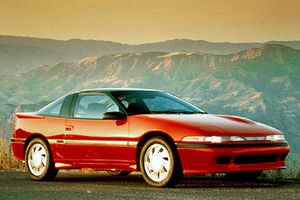
| |
| Mitsubishi Eclipse | |
|---|---|
| Mitsubishi | |
| Production | 1990-1994 |
| Class | Sports Car |
| Body Style | 3-Door hatchback |
| Length | 172.8" |
| Width | 66.7" |
| Height | 51.4" |
| Wheelbase | 97.2" |
| Weight | 2500-2800 lbs |
| Transmission | 5-Speed Manual, FWD/AWD 4-Speed Automatic, FWD/AWD |
| Engine | 1.8L (107 cid) I4 2.0L (122 cid) I4 2.0L (122 cid) Turbo I4 |
| Power | 92-195 |
| Similar | Eagle Talon Plymouth Laser |
First Generation (1G: 1990-1994)
Mitsubishi Eclipse, Eagle Talon, and Plymouth Laser
The first generation Mitsubishi Eclipse was sold as an entry to mid-level four-cylinder sports coupe. Four trim levels were available: the bottom three were front wheel drive and the very top was all wheel drive. The top FWD and the AWD model were equipped with turbocharged engines.
The car underwent minor changes throughout its production; 1992-1994 models have updated sheetmetal and are easily distinguishable from previous vehicles. The Eclipse was revised into a new vehicle for 1995 (described below in the 2G section).
Trim levels
The Eclipse was available in four trim levels during its first-generation production run. AWD models were not available until halfway through the first model year.
- Eclipse: Base FWD model equipped with a 92hp naturally-aspirated engine 1.8 L 8-valve SOHC 4G37 engine
- Eclipse GS: Upgraded FWD model with slightly more equipment
- Eclipse GS DOHC: Upgraded FWD model equipped with a 136 hp naturally-aspirated 2.0 L 16-valve DOHC 4G63 non turbo engine
- Eclipse GS-T: Top FWD model equipped with a 180-195hp* turbocharged 2.0 L 16-valve DOHC 4G63T engine
- Eclipse GSX: AWD model equipped with a 180-195hp* turbocharged 2.0 L 16-valve DOHC 4G63T engine
1990 manual transmission turbocharged models were rated at 190 hp, whereas 1991 and later manual transmission turbo models were rated for 195hp. The automatic models were rated at 180 hp due to smaller fuel-injectors and turbocharger.
These models varied significantly in drive trains, available options, and—to an extent—appearance. The Eclipse GSX, for example, was sold with different plastic body cladding than the base Eclipse.
Drivetrain
The basic driveline layout of the Eclipse is a transverse-mounted 4-cylinder Mitsubishi 4G37 or 4G63 engine situated on the left-hand side of the car driving an automatic or manual transmission on the right-hand side. AWD models have a different transmission which includes a limited-slip center differential and output shaft for a transfer case, which drives the rear differential (also available as limited-slip) and half-shafts.
The 4G37 and 4G63 engines are both in-line 4-cylinder gasoline engines. The 4G63 is composed of an iron engine block and aluminum cylinder head and is equipped with balance shafts for smooth operation. The turbocharged version of the 4G63 (sometimes referred to as the 4G63T) is equipped with a lower compression ratio (7.8 vs. 9.0 in the naturally aspirated version) and oil squirters under the pistons in order to better cope with the stress and extra heat caused by forced induction.
There was also a difference between rear axle/rear ends. 1990-1991 had 3-bolt rear axle assemblies have 3 bolts attaching the axle to the wheel hub. 1992-1994 4-bolt axles have 4 bolts, as well as beefier axle cups, and are therefore far stronger.
Awards
The Eclipse Turbo was on Car and Driver magazine's Ten Best list for 1989 through 1992.
Timeline
Origins
Mitsubishi's experience with sports cars starts in the early 1980s with the development and sale of the Mitsubishi Starion. Up until this point, Mitsubishi Motors had sold cars to the American market rebadged as Chryslers, Dodges and Plymouths. The Starion, similarly sold as the Chrysler Conquest, offered performance and features on-par with sports cars offered by Japanese makers with more experience in performance motoring. The Starion's main competitors were among the largest of the Japanese sports cars: the Toyota Supra and the Nissan 300ZX.
During the Starion's production run (1982-1990), Mitsubishi had no other true sports car offerings for the American market. At the same time (specifically in 1986), Chrysler was discontinuing their Laser sports coupe, which was a rebadged Dodge Daytona.
Mitsubishi Motors and Chrysler founded a new production division, Diamond Star Motors (DSM) in October 1985. The DSM plant was situated in Normal, Illinois and eventually produced cars bound primarily for the American market. The first cars to roll off the lines at this facility were the Mitsubishi Eclipse, Eagle Talon, and the Plymouth Laser.
Worldwide
Design quirks and oddities
Mitsubishi Eclipses were featured prominently in the films Some (1995 Coupe), The Fast and the Furious (1999 Coupe), its sequel 2 Fast 2 Furious (2003 Spyder), and The Last Ride (2005 Coupe). The Mitsubishi Eclipse was also featured in videogames, including, but not limited to: Need for Speed Most Wanted, Need for Speed Carbon, Need for Speed Underground 2, Midnight Club 3: DUB Edition, Street Racing Syndicate, Forza Motorsport and Gran Turismo 4.
Awards
See also
External links
- Mitsubishi Motors US web site
- Mitsubishi Eclipse car pics (CarDomain)
- Mitsubishi Eclipse Specs
- Club DSM
- Team 2G
- Club 3G
- Club 4G Eclipse
- 2G non-turbo site
- Pics Aplenty: 2009 Mitsubishi Eclipse GT and Eclipse Spyder
This page uses content from Wikipedia; see Mitsubishi Eclipse, which includes these contributors.
